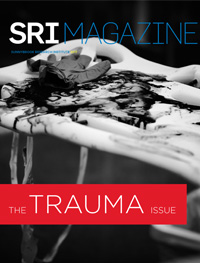
Q&A
Dr. Carol Schuurmans
Dr. Carol Schuurmans joined the Biological Sciences platform and the Hurvitz Brain Sciences Research Program at Sunnybrook Research Institute (SRI) as a senior scientist in 2016. Additionally, she holds the Dixon Family Chair in Ophthalmology Research and is a professor in the department of biochemistry at the University of Toronto. She spoke with Matthew Pariselli about her work and moving to SRI.

Illustration: Hang Yu Lin
What about the brain, particularly the neocortex and retina, fascinates you?
They’re quite complementary. They’re both layered structures in the central nervous system and there are similarities in how they’re structured. The questions are, how are layers developed in these two independent parts of the central nervous system? How do the neurons go to the right layer? How are they born at the right time? I started working on the neocortex and then gradually shifted to the retina, and they both have advantages and disadvantages. The retina is more accessible for therapies—it's external, obviously—and the brain is harder to reach.
What excites you most about your work?
One project I’m excited about is a neocortical project. If you’re making different cell types at different times in development, you have a stem cell pool that you have to retain. So if all the stem cells get used up at the beginning of development, you don’t have enough left to make later-born cell types. We’ve found a new mechanism that controls and maintains this stem cell pool over developmental time. It’s quite exciting because it’s not well studied.
 QUICK FACTS
QUICK FACTS
Neocortex
- It is the outermost layer of brain and accounts for about 76% of the brain’s volume.
- It is involved in sensory perception, motor commands, conscious thought and spatial reasoning.
Retina
- It is located at the back of the eyeball and covers about 65% of the eye’s interior surface.
- It converts images that come through the eye’s lens to electric signals, which are sent to the brain via the optic nerve.
How would you rate your experience at SRI thus far?
I think I’m still in my honeymoon phase [laughs]. Nothing to complain about. I’m really happy here. I like my colleagues. There’s JoAnne McLaurin and Isabelle Aubert, who are my neighbours on either side [of my office]. They both work on neuroscience. We’re starting to do collaborative projects. I have a successful grant already with Isabelle, and I’m writing one now with JoAnne. It’s a really good community.
What are you working on with Isabelle?
It’s a retina project. It looks at using focused ultrasound. So Kullervo Hynynen [director of Physical Sciences at SRI, who pioneered the technology] is also on that grant. We’re using focused ultrasound to deliver cells into the retina to treat blindness, essentially, so to treat the loss of photoreceptors that occur in a lot of the animal and human models of blindness — retinitis pigmentosa, age-related macular degeneration, different diseases.
How do you feel about your role as mentor to the members of your lab?
Every student and trainee is different. They all need different things and different delivery methods. Some you can push; some you can’t. Some need more handholding. It’s interesting that way. I think their excitement is motivating for me, too. So when they get a result and they come in my office and they’re all giddy because something worked, it’s exciting for me to see how passionate they are about what they’re doing.
What words of wisdom would you offer aspiring scientists?
I think right now the funding climate is really difficult, so I would suggest just trying to follow your dreams. If you’re passionate about research and neuroscience in particular, don’t give up. It’s becoming harder and harder to be a scientist because of the way funding is but if you’re passionate about it, keep exploring and don’t give up.
Schuurmans' research is funded by the Canadian Institutes of Health Research and Medicine by Design.



